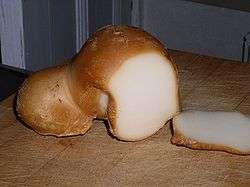Scamorza
| Scamorza | |
|---|---|
 | |
| Country of origin | Italy |
| Region | Apulia and Calabria |
| Source of milk | Cows’ milk |
| Pasteurized | Yes |
| Texture | Elastic, stringy |
| Certification | Prodotto agroalimentare tradizionale (PAT) – 1996 |
Scamorza (Italian pronunciation: [skaˈmɔrtsa]) is an Italian cow's milk cheese, similar to mozzarella. It can also be made from other milks, but that is less common.
Etymology
The term may come from the Italian phrases capa mozza or testa mozzata, both meaning "severed head". This would also explain the use of "scamorza" in Italian to mean "fool" or "idiot".[1][2]
Description
Scamorza is a plastic (or stretched) curd cheese, in which the fresh curd matures in its own whey for several hours to allow acidity to develop by the process of lactose being converted to lactic acid. Artisanal cheese makers generally form the cheese into a round shape, and then tie a string around the mass one third of the distance from the top, and hang to dry. The resulting shape is pear-like. This is sometimes referred to as "strangling" the cheese. The cheese is usually white in color unless smoked. When smoked, the color is almond with a lighter interior.
Scamorza can be substituted for mozzarella in most dishes as can any other cheese, but the resulting taste will be much stronger and more dominant. It is reputed to melt better in baking. Using the smoked variety (scamorza affumicata) adds a nice background flavor in replacement of mozzarella.
Production areas
In Italy, scamorza is more commonly made in the south rather than the north. Strictly speaking, scamorza is a product of Apulia and Calabria.[3] However, it is available across the country, both in the unsmoked and smoked forms. Mario Batali cites grilled scamorza as a traditional dish in Neapolitan cooking.[4] Scamorza in Bari is made from sheep's milk. This is not necessarily true of cheeses called scamorza outside the EU.
See also
-
 Food portal
Food portal - List of smoked foods
References
- ↑ "SCAMORZA di vacca e di bufala". sito.regione.campania.it (in Italian). Retrieved 15 June 2015.
- ↑ "Scamorza: formaggio vaccino a pasta filata, tipico della Campania". formaggio.it (in Italian). Retrieved 15 June 2015.
- ↑ (Slow Food Editore. 2005. Italian cheese, p. 372.)
- ↑ (Batali, M. 2008. Italian grill, p.33.)